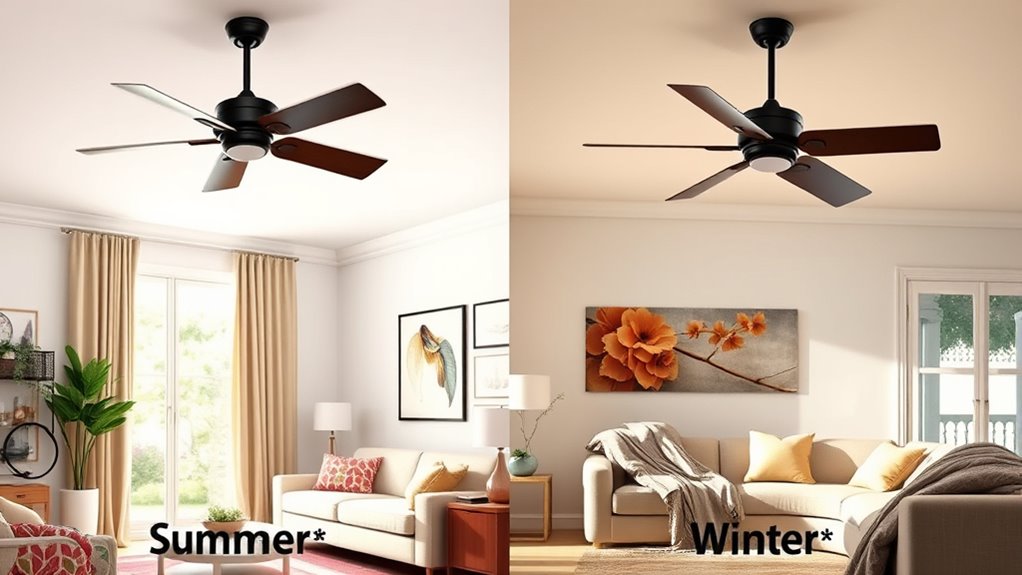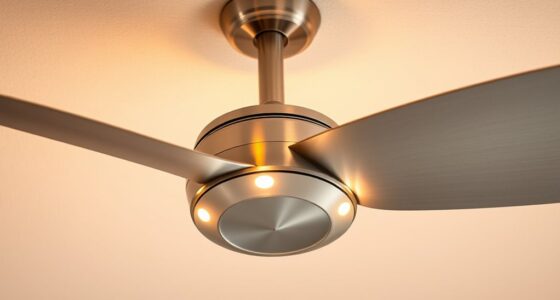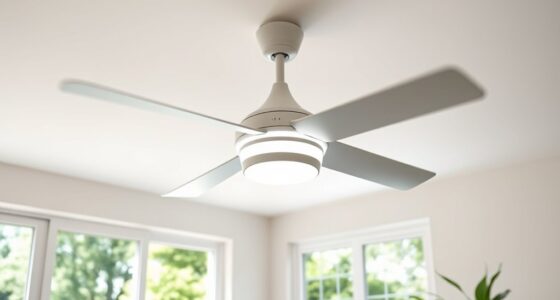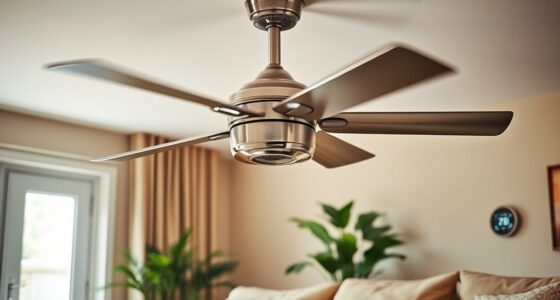To optimize comfort and energy savings, set your ceiling fan to rotate counterclockwise in summer to create a cool breeze and push air downward. In winter, switch it to clockwise to circulate warm air near the ceiling and pull it downward, helping heat the room efficiently. Properly adjusting your fan’s direction can make a big difference in comfort and cost savings, and more tips await if you keep exploring.
Key Takeaways
- In summer, set the fan to rotate counterclockwise to push air downward and create a cooling breeze.
- During winter, switch the fan to clockwise to draw air upward and circulate warm air near the ceiling.
- Proper fan direction reduces energy costs by enhancing heating or cooling efficiency.
- Changing fan direction is a simple adjustment that significantly improves seasonal comfort.
- Using the correct fan direction ensures better airflow and temperature distribution throughout the year.

Have you ever wondered why your ceiling fan has a different setting for summer and winter? It’s a smart feature designed to optimize comfort and efficiency throughout the year. When you switch the fan’s direction, you’re not just adjusting the airflow; you’re also making a conscious choice to enhance your home’s energy efficiency and aesthetic appeal. During the warmer months, changing the fan to rotate counterclockwise creates a breeze that cools you down without the need to crank up the air conditioning, which can appreciably reduce your energy bills. Conversely, in winter, switching the fan to clockwise helps circulate warm air trapped near the ceiling, preventing cold spots and maintaining a cozy atmosphere.
Understanding these directional differences allows you to harness your ceiling fan’s full potential. In summer, the goal is to generate a wind-chill effect that makes you feel cooler even if the air temperature remains constant. When the fan spins counterclockwise, blades push air downward, creating a breeze that accelerates evaporation from your skin. This breeze makes your body feel cooler, reducing the need for air conditioning and saving energy. Not only does this improve your home’s energy efficiency, but it also adds to your aesthetic appeal. A well-positioned fan that moves air effectively can make your space look more inviting and dynamic, especially if it’s a stylish fixture that complements your decor.
In winter, reversing the fan’s direction to clockwise causes the blades to draw air upward. This gentle upward movement pushes the warm air near the ceiling down along the walls, evenly distributing heat across the room. This process helps you save on heating costs because your heating system doesn’t have to work as hard to maintain a comfortable temperature. Plus, the subtle change in airflow can add a cozy ambiance to your room, enhancing its aesthetic appeal by creating a warm, inviting environment. Additionally, proper fan placement can maximize these benefits and ensure optimal airflow for energy savings. The switch is simple, but the impact on energy efficiency and visual harmony can be substantial.
Frequently Asked Questions
Can the Fan Direction Be Changed Easily Without Tools?
You can often change your fan’s direction easily, especially if it has remote control features, making the process simple without tools. Many fans with fan blade materials designed for easy blade movement allow quick adjustments. Just use the remote control to switch between forward and reverse modes. This convenience guarantees you can adjust the fan’s direction comfortably, keeping your space comfortable year-round without needing any tools.
Does Fan Direction Affect Energy Consumption Significantly?
Changing your fan direction can impact your energy savings and fan efficiency. When you switch the fan to clockwise, it helps warm your room by recirculating warm air, while counterclockwise cools by creating a breeze. Although the energy difference isn’t huge, optimizing fan direction alleviates strain on your system and can lower energy bills over time. Properly set fan direction ensures you get the most out of your fan year-round.
Are There Specific Ceiling Fan Models for Seasonal Use?
Imagine your ceiling fan as a chameleon adapting to the seasons. Some fan model options feature seasonal fan switches, making it easy to toggle between summer and winter modes. These specialized models simplify the process, so you don’t have to manually reverse the blades. With the right fan model options, you can effortlessly switch your fan’s direction, ensuring ideal comfort year-round with minimal fuss.
How Often Should I Check and Adjust Fan Direction?
You should check your ceiling fan’s direction and blade alignment during seasonal maintenance, ideally at least twice a year. Regularly inspecting guarantees the blades are aligned properly and the fan rotates smoothly. Adjust the direction if you notice any wobbling or imbalance. Proper maintenance keeps your fan functioning efficiently, saving energy and extending its lifespan. Don’t forget, a quick check now can prevent bigger issues later!
Can Fan Direction Impact Air Quality in the Room?
Your fan direction can influence air circulation, which in turn impacts indoor air quality. When your fan runs efficiently, it helps move air throughout the room, reducing stale or polluted air buildup. Proper air circulation prevents moisture and mold problems, keeping the indoor air quality healthier. So, making sure your fan spins correctly guarantees better air movement, helping you breathe easier and maintain a cleaner, fresher environment inside.
Conclusion
Now that you know which way to set your ceiling fan, you can make every season more comfortable. Imagine your fan as a silent hero, working behind the scenes to keep your home just right. Whether summer’s heat or winter’s chill, setting your fan correctly is the secret weapon in your comfort arsenal. So, flip that switch with confidence—your home’s perfect climate is just a spin away. After all, comfort isn’t just a goal; it’s a rotation of understanding.









